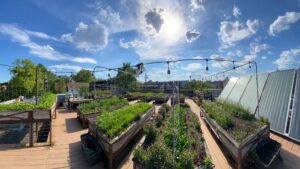
Uncommon Ground — America’s First Certified Organic Rooftop Farm
Founded by Helen and Mike Cameron, Uncommon Ground is America’s first certified organic rooftop farm.
USA
Onalee Duane August 16, 2021
Discovering her love for wine early on in her career, Joann Cherry, co-proprietor of Villa Creek Winery, built up her business on the MAHA Estate outside of Paso Robles, California. The estate sits on a four-million-year-old seabed. The winery prioritizes the cultivation of organic and biodynamic wine. Villa Creek Wines treats both the wines and the whole farm with careful attention. Cherry acknowledges the importance of caring for the ecosystem within the estate, contributing to the preservation of the energy, life, and beauty that nature holds.
MoL: Where did you grow up?
Joann Cherry: Suburban Southern California.
MoL: Where did you go to school, and what did you study?
JC: In high school I was into art, fashion and cooking and the beach. I read a Danielle Steel novel about an advertising account executive and decided that was the career for me. I went to University of San Diego to study marketing and communications.

MoL: Why did you move to Paso Robles? Where did you move from, and what were you doing at the time? What sparked your interest in wine and agriculture?
JC: After college, I worked at an ad agency in Los Angeles that specialized in fashion and lifestyle brands and moonlighted in bartending and catering. That’s where my love of wine began. After dabbling in interior design and set design, I moved back to San Diego to be with the love of my life, Cris, who was running his family’s restaurant.
We decided to get out of Southern California with the goal of finding a place where we could buy a house in the country, open a cutting-edge organic restaurant and be instrumental in affecting positive change. Ideally in California wine country. A friend turned us on to a dive bar on the downtown city park in Paso Robles that was for sale. We had been married at my husband’s family ranch in Cayucos and had been enjoying the wine from Paso Robles so were familiar with the area. We drove up from San Diego and saw a tree lined street, a downtown park with gigantic trees and a Carnegie library and an economically depressed downtown that was ripe for some new energy. The Paso Robles wine business was on an upward trajectory, and we wanted to be a part of that. In 1996 we bought that dive bar and a couple of years later opened Villa Creek restaurant in the downtown city park.
From the time I was a little girl, I loved dirt, growing things and cooking. I made mud pies and acorn mush under the big oak tree in my front yard. I loved planting seeds and watching them grow and working in the garden with my mom. I couldn’t wait to get my hands dirty once we moved to Paso. Our first friends in the area were growers and winemakers, and we immersed ourselves in learning about the process. Growing grapes and making wine had seemed like a pipe dream to a girl from SoCal and a guy from Vail, but after helping out with our first harvest, we knew it was what we wanted to do. More importantly, we knew it was not out of our reach.
MoL: What wine making knowledge did you have prior to creating the Villa Creek label?
JC: Being in the restaurant business afforded us some great opportunities for learning about wine. My husband, being a restaurant guy, is a crazy networker. In addition to picking the brains of our winemaker friends and helping out whenever we could, we attended every trade tasting we could and traveled to Napa and the Rhone to tour the vineyards and wineries of those who inspired us. We launched the brand with a barrel of Syrah blended with Grenache and Mourvèdre that was meant to be a house wine for our restaurant. A Wine Spectator reviewer got his hands on a bottle and did a write-up on us and that’s how the brand was launched.
MoL: Where did you buy your first vines, and what varieties were they?
JC: We made our first 14 vintages with grapes that we purchased from grower friends in west Paso Robles. We bought an old walnut orchard in the hills west of Paso Robles in 2004, and spent several years prepping the land for vineyard and saving money to plant grapes. When we finally planted in 2012 we bought from a reputable nursery in the central valley, as is common protocol in our area. They had the drought-tolerant rootstocks and grape varieties we wanted which included a couple of different clones of Grenache, Mourvèdre, Petite Sirah, Carignan and Clairette, which is a beautiful white Rhone variety. One of my favorite field trips was a visit to the grapevine nursery to see our newly grafted baby vines out in the fields, establishing their roots and waiting for us to prepare our site.
MoL: What inspired you to buy acreage of the MAHA Ranch? What is unique about this property and the natural surroundings? What is the history of the MAHA estate?
JC: The hills west of Paso Robles possess some of the best microclimates and soils for growing Rhone varieties. Our favorite vineyard sources were located near the Vineyard Drive corridor in what is now known as the Willow Creek district. We are both avid cyclists and frequently rode by what is now our property and always thought it would be a nice spot to live and plant a vineyard. A surveyor friend who also happens to be a neighbor told us one day that the owner wanted to sell a piece of this ranch. The price was right so over a glass of lemonade we sealed the deal. The MAHA never even hit the market.
The area sits on a four million-year-old seabed that was a bay where whales came to birth. It was very much like the San Ignacio lagoon in Baja. The alkaline soils help preserve the acidity in the grapes, and the clay topsoils provide nutrients and help with moisture retention, which is critical in our arid climate. The proximity to the Pacific Ocean (14 miles) brings fog and cooling winds which help extend the growing season and results in more complex wines. The surrounding oak forests are teaming with wildlife which is all critical to keeping our ecosystem in balance.
MAHA was the name stenciled on an old tank that used to be on the property, so we had always called it “The MAHA.” Over the years, we have gleaned stories from neighbors about the former owners. Jerry Maha was a glider pilot and walnut farmer who had a penchant for day drinking. We bought the land from his grandson. His walnuts were planted a bit willy nilly. He made a stump puller that his wife Lillian manned. A neighbor recently showed us an old newspaper clipping of Jerry and Lillian and this stump puller they became known for. We don’t know the onomatology of the Maha name, but we like that in Sanskrit it translates to great, a higher place, luster and brilliance. We’ve also been told that a maha is a beautiful woman, and the word has a strong affiliation with the moon. All very relevant to our farm.
MoL: How long did it take to build your wine making business on this piece of property?
JC: A long time! If you don’t come in with buckets of money or bring in a partner, things take a little longer. That time gave us the opportunity to really learn our site, so it wasn’t such a bad thing. We had a lot of work to do before planting including pulling out the dying walnut orchard, removing some boulders and deer fencing. From purchase to planting, it was eight years. Our first MAHA harvest was 14 years in, and the first estate wines were just released in 2019. So for our MAHA Estate wines, it was an 18-year process!
MoL: How does the natural environment inform what grapes to grow? What varieties of grapes do you currently grow at MAHA Estate?
JC: To create a wine that is representative of the site, it’s important to listen to the natural surroundings. If a particular variety is not performing, rather than change the vineyard microclimate with shade cloth and pump it up with chemical fertilizers and extra water, maybe it’s best to yank it out and plant something that is happy in that spot. Grenache loves growing in our location. All of our Grenache vines are really happy, and the resulting wines are magical. We had some trouble with ripening a Carignan block, so we recently grafted it over to Syrah. So far, the Syrah vines are looking much happier in that location than the Carignan was. Our 60 acres go from 1200 to 1800 feet in elevation and have several different exposures. We tried our best to match the rootstocks and vines to the conditions in each block, but really it comes down to trial and error. Ours was the first property to be planted to grapes in our unique west Paso Robles corridor, so we did not have any immediate neighbors to call on for advice.
MoL: What is your wine making process from grape, to harvest, to bottle? How long does it take to make a superior bottle of wine?
JC: If we are purchasing grapes, we wait for the call from the grower, and then someone takes our truck and trailer to pick them up. Our estate harvests start before sunrise, so by nine a.m. all fruit should be in house. We don’t typically pick more than a couple of acres in a day from our vineyard. It’s important to bring the grapes in cold so they don’t start to break down and ferment before we can sort and maybe de-stem. We sort all the red wine clusters on a vibrating sorting table then we might de-stem and berry sort on another table. After that, the grapes go into vats for fermentation. We taste and monitor the ferments daily with Brix (sugar) and temperature readings. We are tasting for tannin extraction and for any off-flavors or aromas. If ferments get stuck (or stop fermenting) or develop off-flavors, only then will we think about intervening with an organic nutrient addition or pied du cuve, which in winemaking is similar to a sourdough starter.
As far as timing, we make a great bottle of rosé in a few months, a fresh carbonic Grenache or Zinfandel in nine months or so, but for our richer red and white wines, they can take up to two years before they are ready to bottle. We like to give the whites a little more time to evolve in the barrel, as they are a richer style. The reds need some time to soften.
MoL: What influenced your decision to grow your grapes without chemical herbicides and pesticides? Your wines are Certified Organic and Biodynamic. What do these certifications actually mean? How do you embrace biodiversity at your ranch?
JC: I have always been an organic gardener. My intuition told me a long time ago that if something kills weeds and bugs, there had to be collateral damage too. We knew that if/when we had a vineyard of our own, it would be organic. Wines from organic and biodynamic vineyards really struck us as having more depth and character than their conventional counterparts. The more we researched biodynamic farming methods, we knew we wanted to farm that way. Biodynamics treats the whole farm as a unit and is about keeping balance, kind of like a human body.
It’s important to support the certifying agencies and all the work they do to promote healthy agriculture and also our certifications give consumers the peace of mind of a third-party endorsement. Representatives visit our farm annually and can see with their own eyes that we are legitimately farming to their standards. They look behind every door and, in some instances, take soil samples. In our minds, if a farm is not certified, then it’s not organic. The new Regenerative Organic Certification (ROC) that we are working on, spearheaded by Patagonia, takes all the tenants of biodynamic, organic and sustainable and wraps them into one. Chemical use in agriculture is out of control, especially in the wine industry!
A side note, look for wines made with organic grapes and/or Demeter biodynamic certified wine. Certified organic wines are not allowed to use any sulfur in the winemaking process. Sulfur is a natural occurring organic ingredient that, in small doses, can keep a wine fresh and alive. Too much, and the wine can taste lifeless and boring. Many natural winemakers do not use any sulfur, nor do they track the élavage of a wine and the wines have little if any shelf life. They often taste amazing upon release then get really funky over time. I’m not knocking the movement as I love many of these wines.
Biodiversity is what really keeps things in check. Our flock of sheep grazes the vineyard in dormant months and the perimeter the rest of the year, trimming the grass and leaving wool (our sheep shed) and fertilizer as they go. We grow a diverse cover crop and let it go to flower and seed to attract a variety of beneficial insects. Our biggest challenges are star thistle and ground squirrels, but we are working through different trials to keep them in check. Nothing worthwhile is easy.
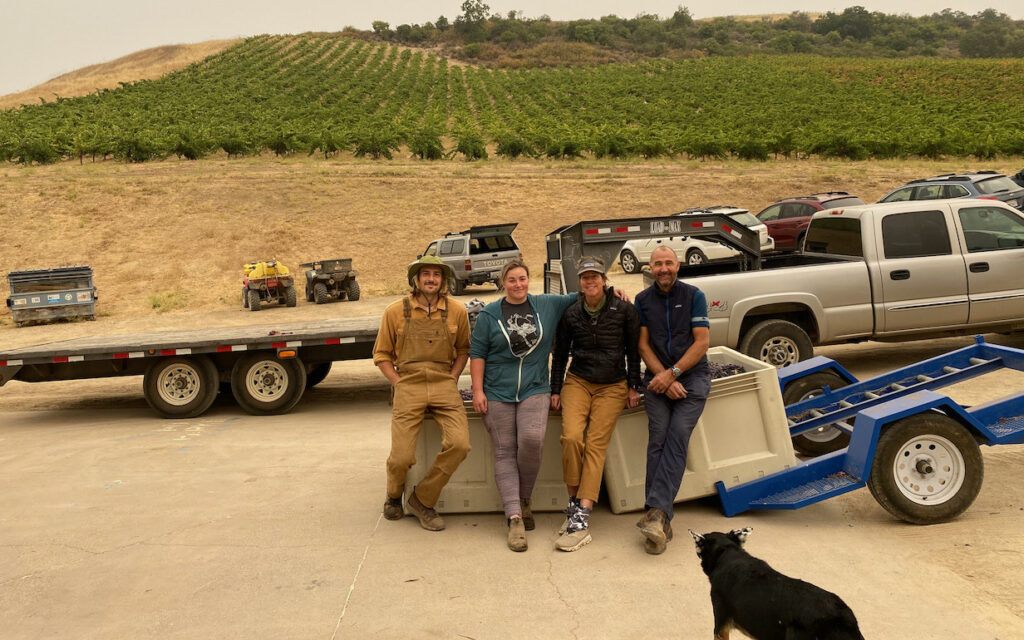
MoL: How has climate change impacted your wine business? What can you do to protect your vines in the future?
JC: We have only been growing for nine years now so not really long enough to see the real impact of global warming, but we know that our vineyard houses its own little ecosystem. We have worked really hard at preserving that. Our farming practices — cover cropping, sheep, compost teas, etc. — aim to keep what’s beneath the soil resilient. These farming practices also help with water retention. Much of our vineyard is dry-farmed, meaning we don’t irrigate at all. In addition to water conservation, this forces the roots to grow deep and the vines to be more adaptable to the changing climate.
MoL: What have you learned creating a wine making business? How has your relationship with nature evolved over the years? What important lessons has this experience taught your children?
JC: I have learned volumes! Cris and I both prefer to learn by doing rather than sitting is a classroom. At one point I wanted to go back to school and study enology to get a better grasp of the chemical processes, but the more time I spend in the cellar, the more I realize that our palates tell us a lot. That said, we want to make sure the wines we make will have a shelf life, and the science is integral to that. We have an amazing winemaker in house who is formally educated but embraces our more natural processes. Just like in the vineyard, in the cellar, it’s all about balance. Balancing nature, art and intuition with science is a good combo in winemaking.
Growing up on a ranch and helping us every step of the way, our kids know more about farming and winemaking than many who have received formal educations. Unfortunately, much of the university education pertains to conventional farming practices, so those kids come out thinking that’s the only way. In addition to learning to be entrepreneurs and wear many hats, our kids have learned that their voices and actions can affect change.
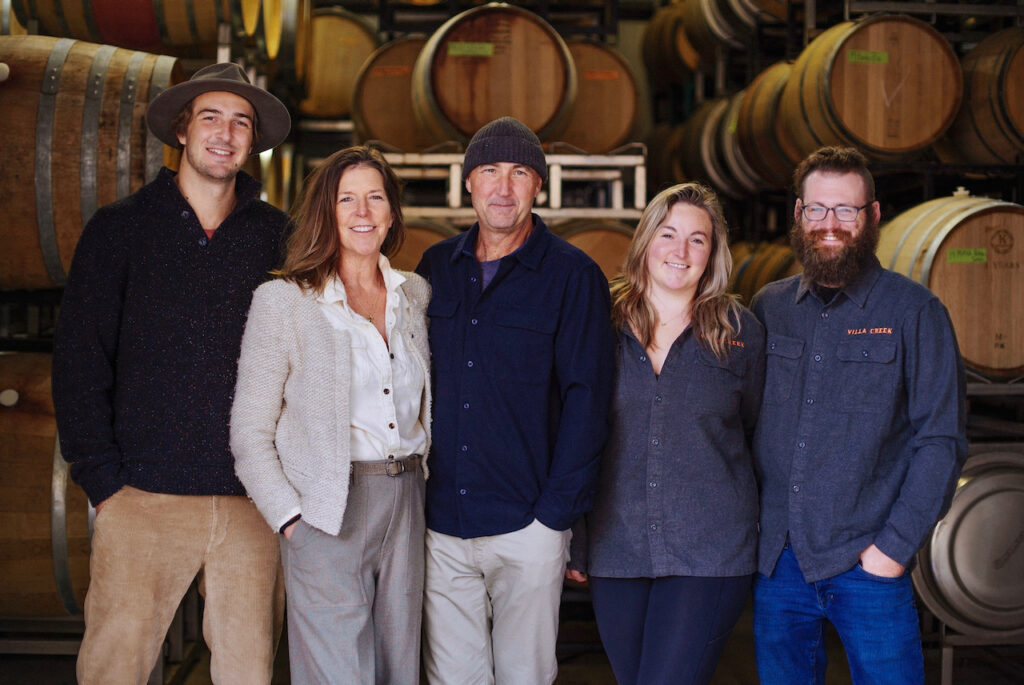
MoL: How do you inspire your visitors? What do you hope they have learned by visiting your winery?
JC: Our vineyard just has so much energy and life, and the vineyard and wines portray that. Visitors are welcomed by our team of working dogs and can often see the sheep grazing. It’s a beautiful place. While we try not to be too preachy about farming practices, I think it’s important for consumers to know that the wine industry has a lot of work to do environmentally. Most vineyards are conventionally farmed and incredibly pesticide-intensive. In fact, California vineyards are second only to almonds in pesticide use. Even “sustainable” vineyard certifications allow for the intensive use of chemical pesticides like Roundup, a fact that they downplay.
MoL: What do you see for the future of Villa Creek Winery?
JC: Villa Creek is the brand we launched with, and we will continue to showcase local organic vineyards in addition to our own vineyard in these wines. We have launched an entry-level brand called Cherry House that we hope to be a leader in the “made with organic grapes” movement. We make a Cherry House red blend, a white blend and a rosé that over-deliver for the price and give consumers access to some great wines that are also good for the planet. The growth of this brand will depend on our ability to source organic grapes, which are with our estate brand, MAHA. We take the best barrels off our property and put together three wines, two reds and a white, that represent the best of our craft.
MoL: What advice do you have for people interested in having careers in sustainable agriculture?
JC: First, we do not want to sustain a dying planet. We are beyond that movement and are now focusing on REGENERATION. Our planet is broken, and it’s our job to fix it, not sustain it as is. Get on the mailing lists of ROC, The Rodale Institute, Kiss the Ground and the Real Organic Project, all of whom offer lots of valuable information and educational opportunities. Intern with companies who are certified and embracing regenerative agriculture. And most importantly, do it, talk it, live it! Your voice, your buying choices, as big or small as they may be, make an impact. As long as we, as consumers, continue to support conventional agriculture, it will persist, and our planet will continue on this UNSUSTAINABLE path.
Photography courtesy of Villa Creek Cellars

Founded by Helen and Mike Cameron, Uncommon Ground is America’s first certified organic rooftop farm.
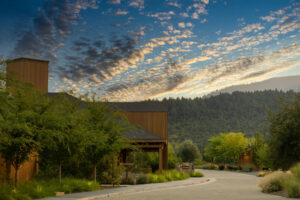
Founded in 1973, Cakebread Cellars is a family-owned business in Napa Valley, CA that utilizes sustainable vineyard practices.
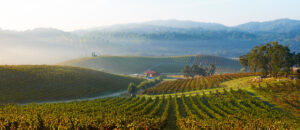
As a pioneer of California wine, Tablas Creek continues to lead the art of blending Califorinia’s Rhone varietals.